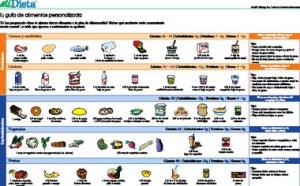Our daily menus are extremely flexible because they are based on the Food Exchange System. This system takes the total calories you should have in 1 day and distributes them in servings of 6 different food groups, assuring that your diet will be varied and balanced. 
MyDiet™ designed an easy guide to control your servings, so you can use it with your meal plan. Print your Food Exchange List here.
The six food groups included are:
- Cereals
- Fruits
- Vegetables
- Milk
- Meats
- Fats
The benefit of this system is that it allows us to provide you with a diet plan that is adapted to suit your lifestyle. You can have the options presented in your daily menu, but you can also exchange foods according to your preferences. It is still very important that you choose healthy options, low in fat and sugar, so you don´t add extra calories to your diet.
In your daily plan, you can see how many servings of each food group you should have in each meal (the number of servings of each category is shown with representative drawings). Your menu was developed based on these servings. You can exchange foods within each food group without altering the total calories of your plan.
The following example will help you visualize how to use the Food Exchange List (remember the number of servings in this example is not necessarily the same as you will find in your diet plan).
If the available food exchanges in your BREAKFAST are:
- 2 servings of cereals
- 1 serving of milk
- 1 serving of fruit
- 1 serving of meat
You can eat exactly what your daily menu indicates, or you can use the Food Exchange List, and have, for example:
- 1 ½ cups high fiber cereal
- 6 oz low fat yogurt
- 1 kiwi
- 1 egg, boiled
The Food Exchange List will show you how much one serving is for each food group, and which foods are included in each category. It is very important that you watch the portion size of your servings, because, for example, 1 cup of rice is not the same as 2 cups of rice, just as 3 ounces of meat is not equivalent to 8 ounces.
You can distribute your servings as you wish throughout the day. For example, if you are used to having lunch as the largest meal, you may use more servings for this time of the day. The secret is to eat the total number of servings that were assigned to you in your diet plan. Print your Food Exchange List here.

